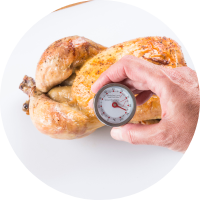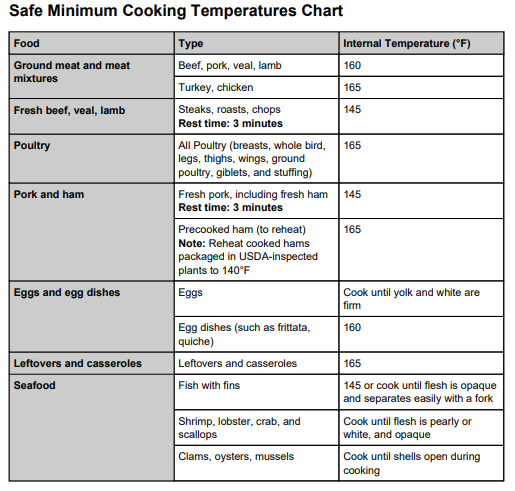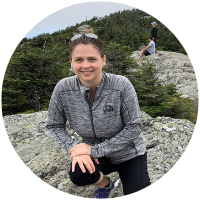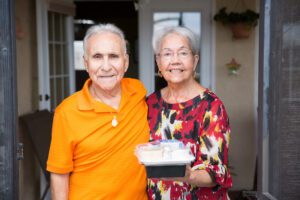According to FoodSafety.gov, food poisoning sickens 1 in 6 Americans a year – that is a huge number! Luckily, you can take simple steps in your home to keep your food safe. These steps are: clean, separate, cook, and chill.
- Keep it clean!


Germs that make people sick lurk around the kitchen, including your food, utensils, cutting boards, countertops, and yes: your hands. Wash your hands, utensils, and work surfaces often.
We have heard a lot about the importance of clean hands in the last year and a half. Clean hands are crucial to keeping your food safe as well. Wash your hands for 20 seconds (the length of “Happy Birthday,” twice), making sure to scrub between fingers, under rings, under nails, and the back of your hands. Dry thoroughly with a clean paper or dish towel, then turn off the faucet using the towel to avoid re-contaminating your hands. When should you wash your hands? Simple answer: often! Before, during, and after preparing food, and after handling raw meat, poultry, seafood, or uncooked eggs. Before eating. After using the restroom, blowing your nose, cleaning a child, or touching a pet. You want to handle food with as clean hands as possible.
The same goes for utensils and food prep surfaces: keep them as clean as possible. Wash cutting boards, dishes, utensils, and countertops with hot, soapy water, especially after they’ve been in contact with raw meat, poultry, seafood, or eggs. Also, wash dishcloths often in the hot cycle of your washing machine to kill germs.
- Separate, do not cross-contaminate!
Cross-contamination occurs when germs are transferred from one surface to another, like dirty hands to raw veggies. It can also happen if you’re using a cutting board to prep raw meat, then use it again to cut vegetables without cleaning it between tasks. Designate a colored cutting board for produce and other uncooked food, and another for raw meat, poultry, and seafood. Also, always use separate plates and utensils for cooked and raw foods.
Store raw meat, poultry, and seafood in the refrigerator in a leak-proof bag or container on a bottom shelf to prevent the juices from escaping and contaminating other foods. Freeze them if you’re not planning to cook them within a few days.
- Cook it right!


Cook the food at the right temperature to kill the germs that make us sick. Use a food thermometer to ensure your food has reached the right temp by placing it in the thickest part, making sure not to touch bone, fat, or gristle. Refer to the Minimum Cooking Temperatures Chart to be sure your food has reached a safe temperature:


Source: FoodSafety.gov
If you’re not eating the food right away, keep it out of the temperature danger zone (between 41°-135°F), in which germs spread rapidly. Use a chafing dish, slow cooker, or warming tray- do not leave food sitting at room temperature for more than 2 hours.
When using the microwave or reheating leftovers, make sure your food reaches at least 165°F. Follow microwave directions to ensure your food is properly heated. So if the instructions say: “Let stand for x minutes after cooking,” there’s a reason for that! Letting microwaved food sit for a few minutes allows it to cook thoroughly as colder areas absorb heat from hotter ones.
- Chill it!


Once again, the goal is to keep food out of the temperature danger zone (41°-135°F). If food is hot enough, germs cannot grow. On the other hand, you also keep germs at bay if the food is cold enough. Set your refrigerator at 40°F or below and your freezer at 0°F or below.
Chill leftovers rapidly to bring them out of the temperature danger zone as fast as possible. To do this, place them in shallow containers and refrigerate or freeze them right away, not after the food has sat on the counter for a while!
Although freezing and refrigerating don’t destroy harmful germs, they will keep your food safe until you can cook it. However, even these methods have their limits! Use refrigerated and frozen foods before they go bad. Not sure how long to keep leftovers? There’s an app for that! Check out the FoodKeeper App, developed by the USDA’s Food Safety and Inspection Service, Cornell University, and the Food Marketing Institute. Its database has food storage tips for over 650 foods and beverages! Learn about the FoodKeeper App: https://www.foodsafety.gov/keep-food-safe/foodkeeper-app
NEED HELP PURCHASING FOOD?
Age Well can help you figure out what programs and benefits you may be eligible for! 3SquaresVT is a federal program referred to nationally as SNAP – Supplemental Nutrition Assistance Program, administered in Vermont by the Department of Children and Families (DCF).
3SquaresVT is an entitlement program, meaning anyone who is eligible can receive benefits.
Eligibility is based on household size, medical cost, housing cost, and income, and how much they are allotted depends on their income. The minimum a person can receive is $16.00 per month; the maximum per person is $194.00 monthly. For a household of two people, the maximum they can receive in total is $355.00.
Many Vermonters who are eligible do not apply because they think they would be taking away from those who are more deserving and in need, or that there is a stigma that comes along with receiving benefits; that is not the case. Anyone eligible will receive benefits, and Age Well staff can help you determine your eligibility!
If you are interested in learning more about 3SquaresVT and seeing if you are eligible, or more about food safety please call the Helpline at 1-800-642-5119.


Written by Age Well’s Registered Dietitian, Brigitte Harton, RD, CD, NBC-HWC.


